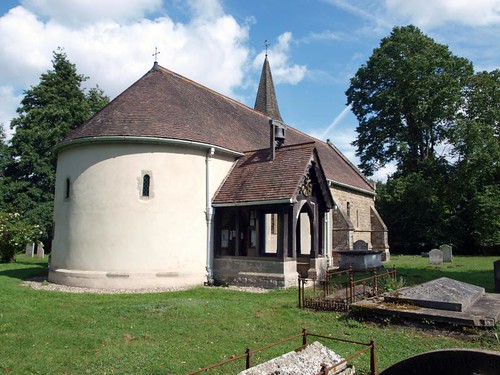Sadly it was locked and heralded a run of disappointment for the end of this trip.
ST GILES. From the outside the church looks at first entirely C19, or the date of its restoration; 1882. It is only when one walks round that one sees a Norman apse, complete with three small windows. The impression is confusing, because an apse in England is only expected at the E end, and the apse at Langford is undoubtedly a W apse - indeed the only one surviving, although it is known that Abingdon about the year 680 had a church with apses at both ends. Langford also had originally an E apse as well. The type is in all probability to be derived from Carolingian and Ottonian Germany, where apses at both ends were quite frequent, though, it is true, not for village churches. Thus, even internationally speaking, Langford was a great exception, and it is much to be regretted that the E apse did not survive the late Middle Ages. Apart from the apse the only Norman evidence is the plain S doorway.
I think there's only one picture I can post:
LANGFORD. Langford Hall has been here since the 17th century, but it is young compared with the church close by, a building of great interest to lovers of old and rare things. Almost certainly it was here in Saxon England, and until the 19th century restorers destroyed some of its character it can have changed little in 900 years. This church is almost unique in England in having a western apse, which is believed to be a survival from the first centuries of Christianity, when a separate baptistry was often built at the west end of a church. The apse has three little windows high up, with wide splays inside. Each is about two feet high, but only seven inches wide. One of the original doorways is here, its inner arch also splayed to allow the door to swing. Through a pane of glass in the plaster wall we can see the rough masonry of the Saxon builders. There is a 15th century font and a double piscina of the 13th century that has lost its pillar. Marks on the chancel floor indicate the foundations of an eastern apse, so that Langford has made itself famous and unique by saving the west apse and losing the east.
Interesting that Pevsner says Norman and Mee Saxon, personally I'd go with the former.
Simon K -
My new friend and I chatted for a while, and when I left he told me to come back and see the church when I was in the area, and 'tell all your friends to come, we like people'. And then off into the countryside proper at last to Wickham Bishops.
Simon K -
Open. The village shop is in the vestry, and the church is open every day from 10am to 12pm, although a very jolly old chap looking after the shop said that it is usually open for longer. He insisted on making me a cup of tea, and telling me about English bagpipes, which he sometimes plays in the church because of the acoustics.
The reason for the acoustics is because this is the only medieval church in England with a round western apse - apparently, there was an eastern one too, but a late Medieval rebuilding of the chancel got rid of it. It presents a most unusual aspect from outside, not least because it has a north-east tower, so everything seems back to front like Dallinghoo in Suffolk. Internally, it is entirely Victorian, but very pleasantly done. Inside, the west end gives an illusion of this being a round-towered church. All in all, this was a lovely place to stop - an interesting church, a decent 19th Century restoration, and above all a very friendly welcome, everything a church should be.

No comments:
Post a Comment